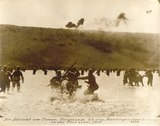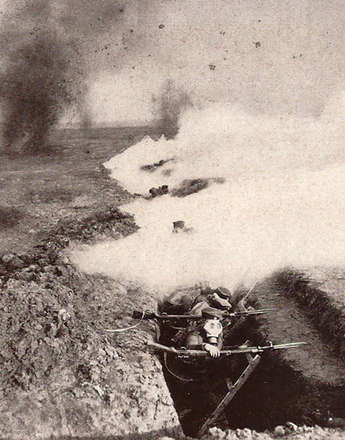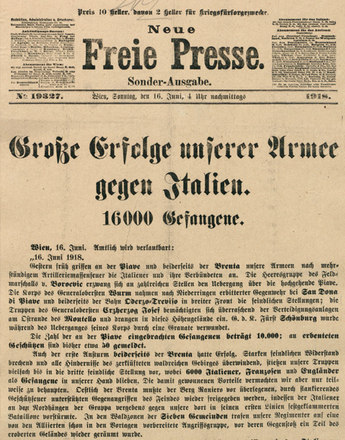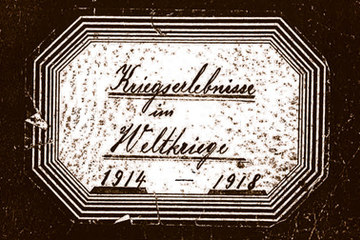-

12th battle of the Isonzo: Austro-Hungarian machine gun group advancing across a ford in a lake, photograph
Copyright: Heeresgeschichtliches Museum, Wien
Partner: Museum of Military History -

Dead soldier in the trench, presumably near Podhajce (Galicia), 1915
Copyright: ÖNB Bildarchiv
Partner: Austrian National Library -

Karl Kraus: The Last Days of Mankind. The Ravens [extract], sound recording between 1930 and 1934
Copyright: Österreichische Mediathek
Partner: Österreichische Mediathek
It was now becoming ever more obvious that the Austro-Hungarian army could only function with massive German assistance. Politically this chained the Danube Monarchy even more firmly to Germany and left it even less freedom to make its own decisions.
Even when he ascended the throne, Emperor Karl knew that Austria could not win the war. As he saw it, the only chance to avoid the imminent downfall of the multi-national Monarchy was to seek peace as swiftly as possible. However, he was soon forced to recognize that his scope for action was very limited.
Vienna was now giving its German ally ever clearer signals of the total exhaustion of the Habsburg Monarchy. However, exploratory peace talks with the Entente Powers failed because of Berlin’s refusal to give up Alsace-Lorraine, which was one of the Allies’ basic demands; nor, it must be said, was Austria-Hungary prepared to give up certain Habsburg territories, in particular in Italy, Poland and the Balkans. There then followed a confusing sequence of secret negotiations and war aim talks that were characterized by a constant oscillation between minimal and maximal variants with regards to territory to be ceded, with the variants being determined by the course of the war at the relevant point in time.
At the end of 1917 the Central Powers found themselves in a paradoxical situation. On the one hand, they were not only succeeding in holding their military positions but were sometimes even making territorial gains. On the other hand, however, their economic and military resources were massively depleted and their supply situation was becomingly increasingly precarious.
The Entente Powers suffered a severe blow in the loss of their Russian war ally after the peace of Brest-Litovsk in December 1917. In the winter of 1916/17 they also had setbacks on the Western Front, when their large-scale offensives were successfully repelled by German forces. For a short period the French army was even on the brink of breaking down.
Nor, at this point in time, was the Habsburg Monarchy so far from breakdown, both moral and material. It had to bring its very last reserves into action even just to maintain the status quo. This is vividly demonstrated by statistics for the Austro-Hungarian army at the end of 1917. Since 1914, of the 8,420,000 men who had been called up, 780,000 had been killed and 1,600,000 taken prisoner; in addition, 500,000 had been wounded to the point of invalidity and a further 130,000 had been retired from military service on account of age.
The Austrian army’s principal theatre of action was the Italian front, where its generals sought to maintain a certain independence vis-à-vis the otherwise omnipotent German high command. Nevertheless, it was initially unable to make any major breakthrough. The challenge of fighting high up in the Alpine mountains confronted the leadership with hitherto inconceivable problems. As in the French theatre of war, both in the Isonzo area and in the Dolomites there was a deadlock between the two fronts with both sides suffering huge losses.
In the autumn of 1917 the weakened Austro-Hungarian army achieved a breakthrough on the Isonzo front at Flitsch-Tolmein (Bovec-Tolmin in present-day Slovenia), not least through the large-scale use of poison gas. Only on the banks of the river Piave shortly before Venice did Italian and British troops succeed in halting the advance. In this surprising success the Austrian army raised its head for one last time before a rapid deterioration set in at the beginning of 1918, when there was no longer any hiding the depletion of its military strength. In the hinterland the political situation was unstable and the supply situation catastrophic. Now even the Austrian generals had to admit that there was no sense in continuing the war.
Translation: Peter John Nicholson
Bihl, Wolfdieter: Der Erste Weltkrieg 1914–1918. Chronik – Daten – Fakten, Wien/Köln/Weimar 2010
Hanisch, Ernst: Der lange Schatten des Staates. Österreichische Gesellschaftsgeschichte im 20. Jahrhundert [Österreichische Geschichte 1890–1990, hrsg. von Herwig Wolfram], Wien 2005
Hirschfeld, Gerhard/Krumeich, Gerd/Renz, Irina (Hrsg.): Enzyklopädie Erster Weltkrieg. Aktualisierte und erweiterte Studienausgabe, Paderborn/Wien [u.a.] 2009
Rauchensteiner, Manfried: Der Erste Weltkrieg und das Ende der Habsburgermonarchie 1914–1918, Wien u. a. 2013
-
Chapters
- The course of the war 1917–1918: Face-to-face with imminent downfall
- The situation in the hinterland
- Apathy and resistance – The mood of the people
- The Sixtus Affair: A major diplomatic débacle
- A programme for world peace – President Wilson’s Fourteen Points
- ‘To My faithful Austrian peoples’ – Emperor Karl’s manifesto
- The collapse
- The disintegration of the Habsburg Monarchy – Part I: On the road to self-determination
- The disintegration of the Habsburg Monarchy – Part II: The situation in Vienna and Budapest
- The last days of the Monarchy








